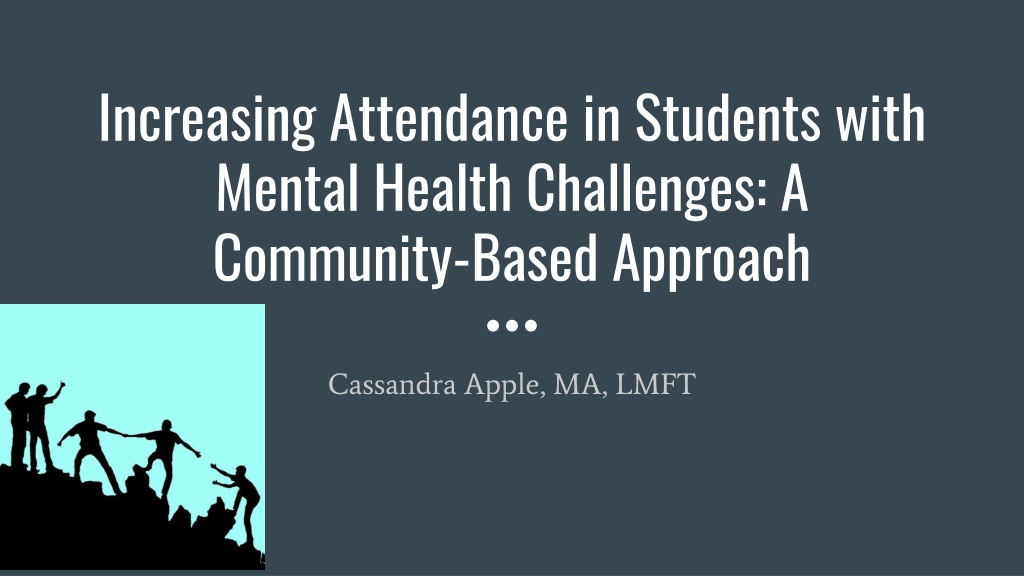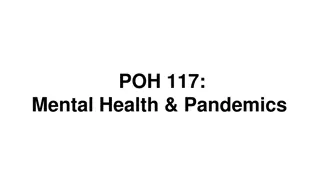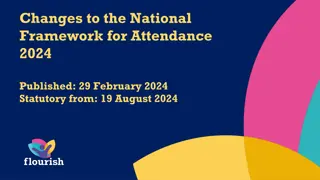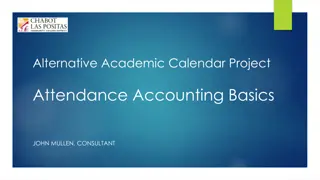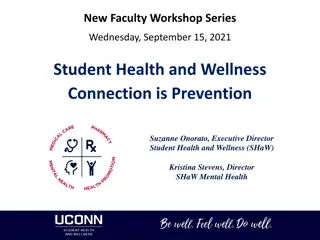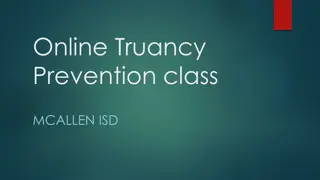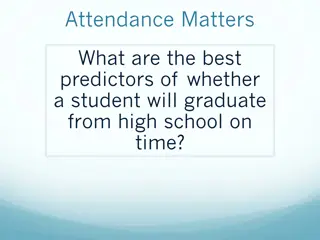Enhancing Student Attendance & Mental Health with Community-Based Approach
Explore the correlation between school attendance and mental health, the significance of assessments in early intervention, and the effectiveness of prevention and early intervention strategies. Learn about the role of a community-based approach in fostering a therapeutic environment for students facing mental health challenges.
Uploaded on Sep 19, 2024 | 0 Views
Download Presentation

Please find below an Image/Link to download the presentation.
The content on the website is provided AS IS for your information and personal use only. It may not be sold, licensed, or shared on other websites without obtaining consent from the author. Download presentation by click this link. If you encounter any issues during the download, it is possible that the publisher has removed the file from their server.
E N D
Presentation Transcript
Increasing Attendance in Students with Mental Health Challenges: A Community-Based Approach Cassandra Apple, MA, LMFT
Overview The Link Between School Attendance & Mental Health The Use of Assessments for Early Intervention & Identification A Community Based-Approach Definition Logistics Interventions Virtual Supports Critical Role of the SBMHP Student & Parent Testimonials Resources References
School Attendance and Mental Health ADA = Average Daily Attendance = Total number of days of student attendance divided by the number of total days in the regular school year. CA chronic absenteeism is defined as 10% or more days absent in a school year. Federal chronic absenteeism is defined as being absent for 15 days or more in a school year. Approximately $60 a day for every student absent A 2019 study by David Lawrence and colleagues found that students with a mental disorder at all grade levels had lower attendance than those students without a mental disorder. The most common were found to be ADHD and anxiety.*
The Role of Assessments Identifying Strengths/Barriers: Taking a close look at current and past psychological assessments. Link between ACE s (Adverse Childhood Experiences Questionnaire) & BASC Results in a 2020 study indicate that the students with self-reported elevated ACE scores correlated with multiple at-risk and clinically significant index and composite scores on the broadband BASC-3. The results support the use of SEL screening measures that seamlessly and psychometrically link secondary- and tertiary-level diagnostic tools in a multi-gating format in MTSS.** Monitoring Progress: Implementing regular use of pre and post assessments to measure efficacy of specialized programs and interventions. DSM Cross Cutting Symptoms Measure (Level 1 and Level 2)
Prevention & Early Intervention Prevention & Early Intervention Works! One recent study (2020) reveals an app-based counseling intervention for elementary students resulted in improved communication, cooperation, assertion, responsibility, empathy, engagement and self control, as well as a significant decrease in problematic behaviors. *** A screening and prevention program for depression and suicide used by counselors/school psychologists was found to cause a noticeable increase in student s help-seeking behaviors and decreased suicidality. ****
Defining Community-Based Approach What it is: What it is: The creation of a therapeutic environment which strives to provide every person with a deep sense of connection and belonging; an environment which everyone contributes according to their strengths and comfort levels; an approach that values inclusivity, connectedness, non-judgment, validation, unconditional positive regard. What It Isn t: What It Isn t: Punitive or perceived as punitive, divisive, level/point systems, rigidity A wealth of research has indicated that students do better when they have a community-like environment at school.
Introduction of Community-Based Program Designed as a program to serve Special Education students who struggle with primarily internalized mental health issues. Staffing: Special Education teacher(s), specially trained instructional aides (Behavioral Health Support Aides), heavy involvement of a qualified mental health professional to provide direct services and ongoing assessment and guidance of therapeutic intervention in the classroom, consistency in school psychologist preferred Services: Individual and group counseling, specialized academic instruction Location: Alternative education campus preferred IEP s: Qualification for special education/focus on individualized plans Note: In this presentation, the program is referred to as the SEAL (Social Emotional Academic Learning) Program.
Typical Student Profile Special Education students, not ALWAYS qualifying under Emotional Disturbance. Students who are chronically absent, particularly on comprehensive campuses Students who are chronically absent, particularly on comprehensive campuses Students with a tendency to display less externalizing behaviors (aggression, property damage, etc.) and more internalized behaviors (self-harm, panic attacks, suicidal ideation, etc.). Outside diagnoses of depression, anxiety, mood disorders, OCD, social anxiety, PTSD, personality disorders, etc. History of psychiatric hospitalizations, placement in residential treatment, self- harm, anxiety/panic disorders and trauma history. Often feels outcast , has little to no peer support/friendships, feels different than the typical high school student.
Early Indicators of Success 2017 2017- -2018 2018 2018- -2019 2018 The program was opened and served 9 students with an average attendance rate of 59%. 2019 Community-based interventions were implemented. The program served 15 students with a 56% average attendance rate. 2019- -2020 2020 The program served 16 students with a 75% average attendance rate. 2019 Up Next: Up Next: In-depth data on classroom attendance, engagement and credits earned as well as more regular use of ongoing assessment to measure mental well-being and stability.
Staffing Solid sense of boundaries and self-control: allowing for appropriate self-disclosure and transparency. Human-ness: willing to be vulnerable & genuine. Unconditional Positive Regard: Keeps coming back to the table, non-judgmental, open. Collaborative spirit & willingness to learn about mental health. Bonus: Sense of humor! Training is necessary, but not sufficient.
Interventions & Ideas Collaboration With Outside Mental Health Providers & Families Evidence-Based Therapeutic Approaches (ACT) Student Involvement in Creation of Program Values Utilizing Strengths of Individual Students Classroom Setup & Choices (Perceived Sense of Control) Activities Which Promote Camaraderie, Engagement and Laughter Personalized Incentives vs. Level System De-stigmatizing Mental Health Traditions and Classroom Staples Welcoming New Students Graduation Event
Supporting Students Virtually Keep that Community Vibe Going via Virtual Platforms Morning Class Chats Porch Drop Off s/Check-in s Birthday Celebrations Movie Days Students do the Teaching Meeting Pets Keep them engaged!
Case Study Hayley, 12th grade, 17 years old Hayley, 12th grade, 17 years old Entered TVUSD in 8th grade and was attending public school. Qualified for SPED in 3rd grade due to a Speech and Language Impairment, but was exited in 5th grade after meeting all goals. Was reassessed in 10th grade due to social and emotional difficulties and qualified under Emotional Disturbance. At this time, her psychiatrist recommended home hospital services. An ERMHS assessment was completed to explore alternative options. BASC-3: Mother reported Clinical Significance in area of Withdrawal. Teacher reported Clinical Significance in Aggression, Anxiety, Depression, Somatization, Atypicality, Withdrawal, Adaptability, Social Skills, Leadership. Full Scale IQ of 93, all other domains Average Symptoms of depression and obsessive-compulsive disorder began appearing in 8th grade. No history of behavior in school.
Case Study, cont. Attendance Record Attendance Record 8th grade 8th grade (1st semester at public school): 20% absenteeism 8th grade 8th grade (2nd semester in virtual school): 74% absenteeism 9th grade 9th grade (Aug-Oct in public high school): 40.54% absenteeism 9th grade 9th grade (independent study): 56.34% absenteeism 10th grade 10th grade (independent study until Feb): 58.93% absenteeism 10th grade 10th grade (placed in SEAL): 35.29% absenteeism 11th grade 11th grade (SEAL): 12.5% absenteeism Credits Credits 9th grade: 5 credits earned 10th grade: 52 credits earned 11th grade: 80 credits earned
Case Study, cont. As I first walked into the classroom, I was a little nervous at first--naturally. But besides that initial nervousness and my social anxiety in general, you can feel this classroom having this welcoming, relaxed atmosphere. The classroom soon became a place where I feel safe and accepted by my peers. It kinda feels like a family. We support and encourage one another. For once in a fairly long time I looked forward to going to school and the chance of socially interacting with other students. In the past, I absolutely dreaded the thought of going to school. My social skills have certainly improved since joining the program and I ve come a long way to get to where I am- academically, emotionally. I was expected, at the rate I was going, to never finish high school. This program put my life back on track, and I am so grateful for that.
Parent Testimonials The relaxed environment and being in a small setting with kids that also struggle with like issues and also with the same instructor and counselor have been life saving for her. Even though her struggles continued and she has had pockets of absences that continue to be challenging, she has found a great emotional home to get her education. The SEAL program was introduced by her team, and was truly her/our last hope. We decided it was the best path to just get her through high school. Kristen is a new student, daughter and classmate since enrolling in SEAL and much more than just getting through . She continues to show success within the academics of the program, but more importantly, her emotional strength is soaring. SEAL creates an atmosphere where she knows she is in a safe place with the guidance and support from staff and classmates. She now looks forward to attending class and has become a friend, a leader and happy high school student! Simply put - the SEAL program has been life changing for Kristen and for our family.
Parent Testimonials When life is derailed it seems like it will never be normal again, but surprisingly, Derek has really bounced back. It s hard to believe that Derek is the same boy who was too afraid to step into a classroom. He still can t function in a traditional school, but he is thriving in the SEAL program. He doesn t dread going to school, he gets out of the car, and confidently walks in like a boss. He s finally interacting with other students, and he s even in contact (on-line) with his friends from his old school. He s participating academically and is close to catching up enough to graduate. I ll admit, I have cried more times than I d like to admit, worried for the future of my son. But Ms. Kniffin and Ms. Apple (et al) have been very supportive every step of the way. The SEAL program offered a non-judgmental, safe space for my son where he feels like he belongs and thrives. The success of the SEAL program lies in the (small) manageable size of the class coupled with the expertise, patience and support of the collaborative team.
Parent Testimonials Thankfully, the SEAL program came along and although Julie still struggles with social anxiety and school refusal, the overall results have been very encouraging. Due to the small and cozy environment, Julie does not feel the crushing stress of being in a sea of students constantly moving from one class to another. She is able to attend more often and actually focus on getting work completed instead of worrying about being in a classroom where she feels as if everyone is judging her. She feels supported and validated by the staff who are equipped to deal with students like Julie. I am confident that had it not been for the SEAL program and the support from the staff, Julie would not be attending school at all. I had literally given up hope that she would get any sort of education. I am so thankful for this outstanding program and for the staff who are so nurturing and kind. I am also thankful to the School District for providing this program as I am sure my daughter would be lost without it. The staff in the SEAL program refuse to give up on my daughter. They communicate with me regularly and offer support that I can use at home to encourage her.
Critical Role of School Based Mental Health Providers School Psychologists, Counselors, Therapists, Social Workers, etc. Our Mental Health Background Drives Classroom Culture Building Capacity for Others Constant Presence & Influence
Resources JOURNALS (THAT DON T SUCK) JOURNALS (THAT DON T SUCK) Start Where You Are This is Me: Put Your Feelings Here GAMES GAMES Mad Libs Telestrations Minute to Win It GROUP CONVERSATION STARTER GROUP CONVERSATION STARTER Chill, Chat, Challenge
References *Lawrence, D., Dawson, V., Houghton, S., Goodsell, B.& Sawyer, M.G (2019). Impact of mental disorders on attendance at school. Australian Journal of Education. **Fletcher-Janzen, E. & Harrington, E (2020). Translating ACE research into multi-tiered systems of support for at-risk high school students. Journal of Pediatric Neuropsychology. ***Bardhoshi,G., Swanston, J. & Kivlighan, D.M. (2020). Social-behavioral stories in the kindergarten classroom: An app-based counseling intervention for increasing social skills. Professional School Counseling. ****Erickson, A. & Abel, N. R (2013). A high school counselor s leadership in providing school-wide screenings for depression and enhancing suicide awawareness. Professional School Counseling, 16)5), 283-289.
Contact Information E E- -mail: mail: capple@tvusd.us Work Cell Work Cell: 951-365-1474 Reach out at any time with questions, comments or just to start a conversation!
